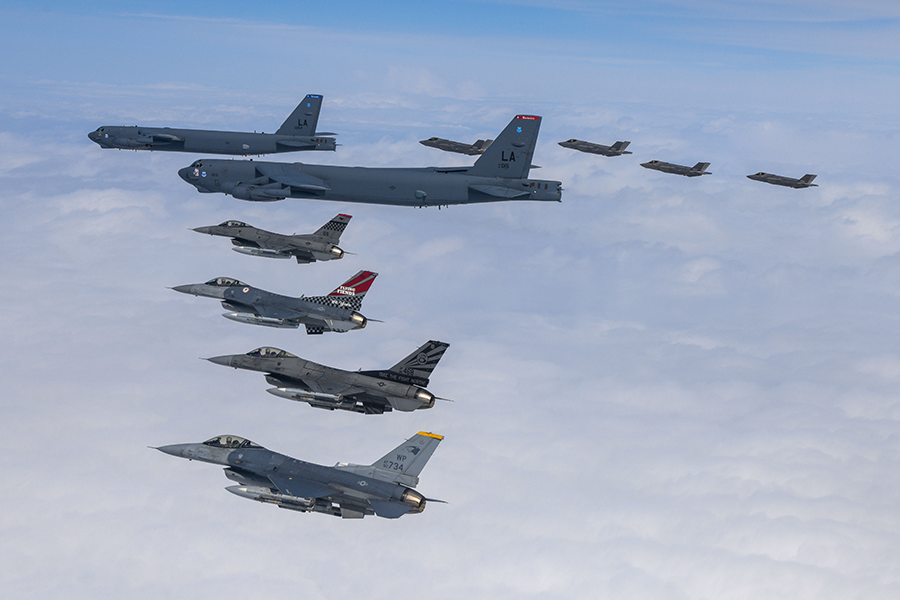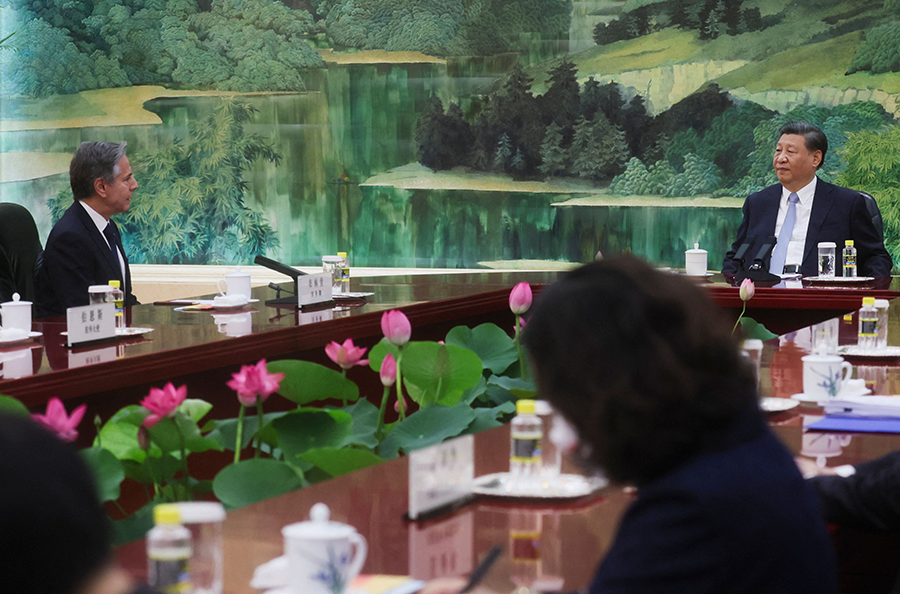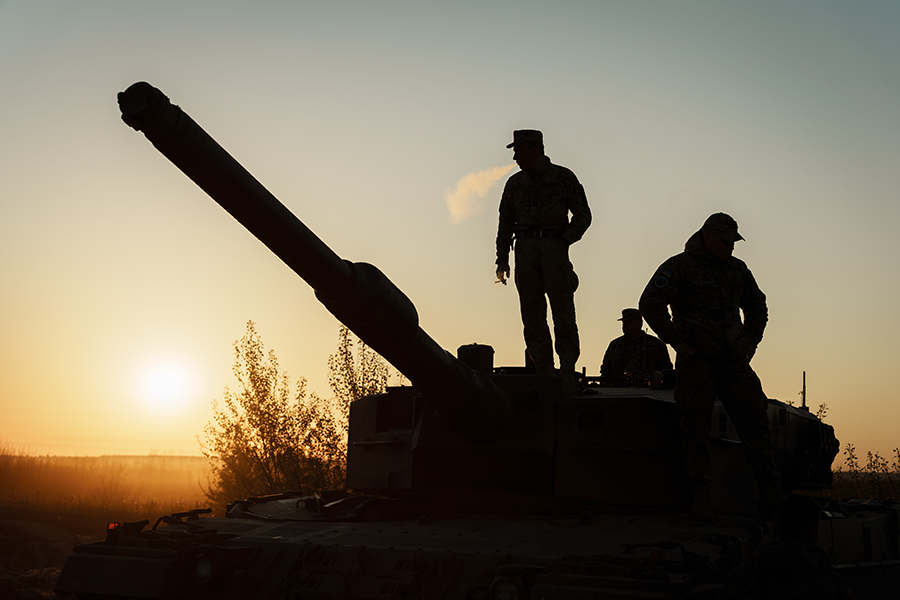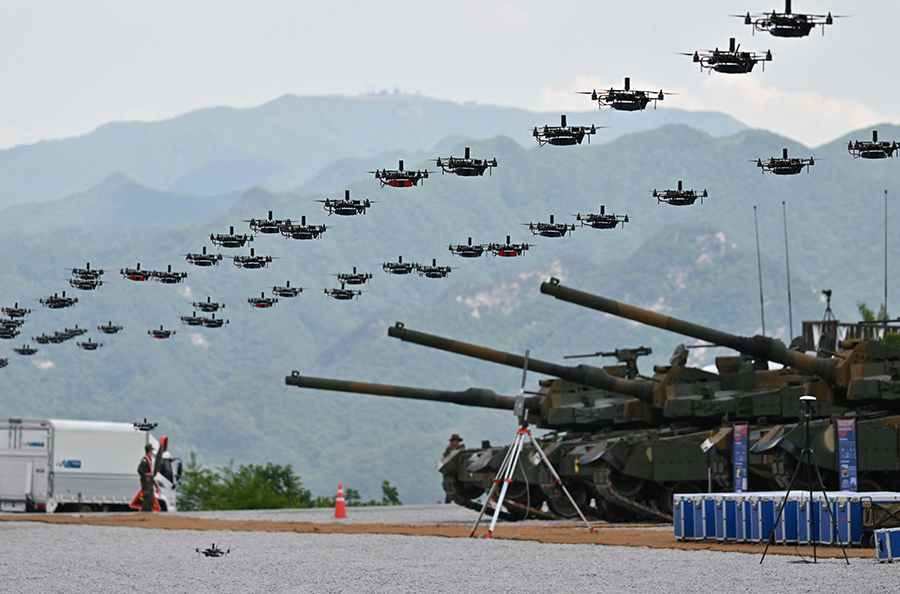"[Arms Control Today] has become indispensable! I think it is the combination of the critical period we are in and the quality of the product. I found myself reading the May issue from cover to cover."
As World Order Shifts, So Does South Korean Security Policy
July/August 2023
By Seukhoon Paul Choi
With the international order in flux, South Korea is at a critical juncture. Russia’s full-scale invasion of Ukraine, China’s aggressive behavior toward Taiwan, and North Korea’s transforming nuclear force posture pose distinct but interconnected challenges.
 As in the cases of China and Japan, this strategic landscape has inspired changes to South Korea’s national security strategy. The administration of President Yoon Suk Yeol has adopted a defense-driven nuclear nonproliferation policy that centers on deterrence as its principal approach to risk reduction and arms control. South Korea is seeking to address the increasing threats of aggression, inadvertent escalation, and nuclear use by signaling advances in its conventional capabilities and its military cooperation with the United States. While continuing to forgo nuclear armament, South Korea is aiming to deny North Korea gaining an advantage from its expanding nuclear weapons arsenal and to shape conditions that are more conducive to a productive dialogue on arms control.
As in the cases of China and Japan, this strategic landscape has inspired changes to South Korea’s national security strategy. The administration of President Yoon Suk Yeol has adopted a defense-driven nuclear nonproliferation policy that centers on deterrence as its principal approach to risk reduction and arms control. South Korea is seeking to address the increasing threats of aggression, inadvertent escalation, and nuclear use by signaling advances in its conventional capabilities and its military cooperation with the United States. While continuing to forgo nuclear armament, South Korea is aiming to deny North Korea gaining an advantage from its expanding nuclear weapons arsenal and to shape conditions that are more conducive to a productive dialogue on arms control.
Threat Environment and Security Challenges
Rising geopolitical tensions pose multiple security challenges for South Korea. Host to a U.S. joint force presence of nearly 30,000 troops, South Korea likely would be implicated in any major regional conflict that involved the United States. South Korea is within China’s anti-access area-denial perimeter and is situated closer to China’s Northern Theater Command than Washington D.C. is to Boston. Joint exercises by China and Russia within South Korea’s Air Defense Identification Zone, their force presence in the eastern and western seas, deployment of space and cyberwarfare capabilities, and increasing support for North Korea underscore South Korea’s precarious environment.
These challenges compound the acute threat that North Korea poses. South Korea’s most populous cities are within range of nearly 6,000 North Korean artillery systems. An unrestrained North Korea continues to build increasingly sophisticated missile capabilities and delivery platforms for its proliferating nuclear arsenal. The regime has simulated nuclear strikes on South Korea. It has displayed long-range missiles in sufficient volume to overwhelm U.S. homeland missile defense systems and challenge the credibility of U.S. extended deterrence commitments to South Korea. The regime of North Korean leader Kim Jong Un has rejected explicitly the possibility of denuclearizing the country without the global elimination of nuclear weapons.1 Instead, it has declared its determination to grow exponentially its arsenal of theater nuclear warheads and to develop a rapid intercontinental counterstrike option.
Through enactment of its 2022 Nuclear Forces Policy Law, North Korea also has adopted a nuclear first-use doctrine that lowers the threshold for employing such weapons on the Korean peninsula. Previous laws specifically limited the role of North Korean nuclear weapons to deterrence and messaged conditional restraint of use against non-nuclear-weapon states. Now, vague conditions have been set to allow North Korea to use nuclear weapons preemptively, including to seize the initiative in conventional contingencies, to end a protracted conflict, and even to respond to a catastrophic political or economic crisis.2
The perceived threat of nuclear weapons to South Korea also has increased with a recognition of the various ways that they can be used across the timeline of crisis and conflict. Interpreting Russian President Vladimir Putin’s threats of nuclear weapons use as having influenced the type and pace of support that the United States and other countries have provided Ukraine, North Korea and China may view these weapons as enabling them to manage escalation. Such nuclear threats are now more likely to be considered effective in limiting conventional support to a country from its allies. This would make the shadow of nuclear weapons a conventional force multiplier, shifting the balance of non-nuclear forces in a conflict and reducing the strategic advantage that alliances may provide.
In addition to influencing escalation dynamics, nuclear threats may mitigate the political impact of operational defeat and lead to more favorable terms in conflict termination negotiations. In a major war, nuclear threats may provide insurance for regime survival. Mutual vulnerability between Russia and the United States is likely to be understood by North Korea as explaining the absence of U.S. threats to end the Putin regime. This understanding can be expected to strengthen North Korea’s resolve to expand its capacity to conduct a nuclear attack on the U.S. homeland.
Such a capability need not threaten complete destruction to be effective. Neither parity in arms nor in vulnerability is necessary to achieve the desired political effect. Establishing reasonable confidence in a limited but survivable nuclear second-strike capability may be sufficient for North Korea to curb threats to its regime. Strategically aligned with South Korean efforts to counter the North Korean nuclear threat, U.S. declaratory policy states that any North Korean nuclear attack would result in the regime’s end. The dynamics of the Russian war on Ukraine are likely to strengthen North Korea’s focus on expanding its arsenal so that it can inspire a degree of U.S. restraint similar to how the United States treats Russia and China.
These trends in the strategic environment are exacerbating South Korean concerns about the design and operation of its alliance with the United States. Russia’s war in Ukraine provides sobering reminders of similarities between South Korea and Ukraine. South Korea is a non-nuclear-weapon frontline state, lacking its own strategic depth but constituting such for the United States and partner countries. As in the case of Ukraine, this may inspire differences in perspective among partners on approaches to deterrence and waging war. Concerns about a conflict escalating to expand geographically likely will vary depending on whether a country’s defense strategy entails deploying forces to fight a conflict away from its shores or whether a country is already the battleground, as in the case of South Korea. As with Ukraine’s decision to give up its post-Soviet nuclear arsenal in return for security assurances, a major factor in South Korea’s policy of forgoing nuclear armament has been U.S. security guarantees, including a commitment of credible nuclear deterrence.
 South Korea’s status as a U.S. treaty ally inspires greater confidence in the U.S. security commitment than Ukraine enjoyed and in Washington’s readiness to back this guarantee with the full range of its capabilities, including nuclear weapons. Seoul appreciates that the forward deployment of U.S. forces to South Korea, as well as broad economic cooperation and the depth of its people-to-people ties with the United States, underwrites the U.S. commitment to support South Korea’s defense. Seoul also recognizes, however, the inherent uncertainty of future U.S. political leadership and decision-making. It understands that when faced with resource constraints, the primary strategic priority of the United States is competition with China.
South Korea’s status as a U.S. treaty ally inspires greater confidence in the U.S. security commitment than Ukraine enjoyed and in Washington’s readiness to back this guarantee with the full range of its capabilities, including nuclear weapons. Seoul appreciates that the forward deployment of U.S. forces to South Korea, as well as broad economic cooperation and the depth of its people-to-people ties with the United States, underwrites the U.S. commitment to support South Korea’s defense. Seoul also recognizes, however, the inherent uncertainty of future U.S. political leadership and decision-making. It understands that when faced with resource constraints, the primary strategic priority of the United States is competition with China.
These considerations inspire nuanced fears of abandonment that are a factor in South Korea’s threat assessments. There is a persistent concern that the potential reelection of former President Donald Trump or the election of someone with a similar foreign policy outlook will result in the reduction or elimination of U.S. military support for South Korea. In any less extreme shift of U.S. political leadership, South Koreans generally have high confidence in the credibility of U.S. defense commitments. Nevertheless, there is growing concern, regardless of U.S. administration, about the U.S. willingness to assume greater risk, including a potential nuclear attack on the U.S. homeland, to deliver military support at the level and speed that South Korea may deem necessary for effective deterrence and defense in a crisis. Simply, it is less a question of whether the United States will come to the defense of South Korea than of when, how, and with what means it will do so in an environment of increasing risk.
This uncertainty about the nature of U.S. support is derived in part from the understandable U.S. focus on China, as well as the need to consider the risks of opportunistic aggression and of simultaneous conflicts. Discourse on “strategic discipline,” or the need for near-singular U.S. concentration on the challenge of China’s revisionism, highlight for South Korea the potential constraints on U.S. support in contingencies on the Korean peninsula.3 South Korea would rely on assets from U.S. Indo-Pacific Command and support from other U.S. combatant commands in any major contingency on the peninsula, and it fears that the United States may be reluctant to fully meet its commitment to South Korea as it seeks to ensure readiness against potential Chinese action in the Taiwan Strait. Similarly, South Korea must prepare for a scenario in which the United States is already engaged in a conflict with China and North Korea considers this an opportunity to conduct its own attack. Although sharing U.S. concerns about confronting two near-peer nuclear adversaries in Europe and in the Indo-Pacific region, South Korea understands that it and the United States also must prepare for simultaneous intraregional crises.
 Finally, even if the United States has the political will to deliver military support to South Korea, there is growing concern about its capacity to do so in the near term due to defense supply chain challenges. As a result of the Russian war in Ukraine, diminishing stockpiles have required the United States to “borrow” 500,000 artillery shells from South Korea.4 To assist Ukraine in its fight against Russia, the U.S. Department of Defense also has sought to draw from U.S. military stockpiles prepositioned on the Korean peninsula for potential contingencies there.5 The United States is expanding its defense manufacturing capacity, but creating new sources of production will take time. Further, even when such conventional stocks are available for deployment, shortfalls in strategic lift and increasingly contested logistics pose significant challenges to the timely provision of such support.6
Finally, even if the United States has the political will to deliver military support to South Korea, there is growing concern about its capacity to do so in the near term due to defense supply chain challenges. As a result of the Russian war in Ukraine, diminishing stockpiles have required the United States to “borrow” 500,000 artillery shells from South Korea.4 To assist Ukraine in its fight against Russia, the U.S. Department of Defense also has sought to draw from U.S. military stockpiles prepositioned on the Korean peninsula for potential contingencies there.5 The United States is expanding its defense manufacturing capacity, but creating new sources of production will take time. Further, even when such conventional stocks are available for deployment, shortfalls in strategic lift and increasingly contested logistics pose significant challenges to the timely provision of such support.6
Drivers of Change
These threats and challenges have inspired a redesign of South Korea’s security strategy. Whereas the former Moon administration pursued an engagement-driven nonproliferation policy, that of the Yoon administration is led by defense. This change reflects a need to respond pragmatically to past and ongoing limitations to nuclear nonproliferation efforts and to the growing threats that South Korea faces. South Korean policy aims to convince North Korea that, despite its nuclear proliferation, its weapons will be “unusable” as coercive tools enabling lower-level conventional aggression or ordnance detonated in theater as part of an attack.7
South Korea’s prioritization of and design for deterrence aims to reduce the risk of an emboldened nuclear-armed North Korea acting aggressively, as well as to establish favorable conditions for arms control diplomacy that would limit the utility and negotiating leverage of these weapons. In addition to strengthening its own non-nuclear strategic capabilities, South Korea is working with the United States to increase the credibility of a combined alliance deterrence posture.
 The government of President Moon Jae-in pursued dialogue with North Korea as a means to establish inter-Korean peace and denuclearize the peninsula. It balanced engagement with defense efforts, implementing a vision of “peace through strength” that invested heavily in bolstering South Korea’s advanced conventional capabilities. It also worked to make its forces and its alliance with the United States appear less threatening to North Korea. It muted deterrence signaling, such as shows of force. It reduced the scope and scale of combined theater-level exercises with the United States, relabeled these efforts to emphasize a focus on defensive training, and ceased the work of the Extended Deterrence Strategy and Consultative Group, which advanced policy coordination to counter North Korea’s nuclear threat. Through engagement, the Moon administration aspired to demonstrate its reconciliation-focused agenda and to reduce the risk of conflict by lowering tensions. It sought to facilitate dialogue between North Korea and the United States aimed at détente and denuclearization. The Moon government also forged a Comprehensive Military Agreement with North Korea, through which the two countries adopted behavioral arms control and confidence-building measures.
The government of President Moon Jae-in pursued dialogue with North Korea as a means to establish inter-Korean peace and denuclearize the peninsula. It balanced engagement with defense efforts, implementing a vision of “peace through strength” that invested heavily in bolstering South Korea’s advanced conventional capabilities. It also worked to make its forces and its alliance with the United States appear less threatening to North Korea. It muted deterrence signaling, such as shows of force. It reduced the scope and scale of combined theater-level exercises with the United States, relabeled these efforts to emphasize a focus on defensive training, and ceased the work of the Extended Deterrence Strategy and Consultative Group, which advanced policy coordination to counter North Korea’s nuclear threat. Through engagement, the Moon administration aspired to demonstrate its reconciliation-focused agenda and to reduce the risk of conflict by lowering tensions. It sought to facilitate dialogue between North Korea and the United States aimed at détente and denuclearization. The Moon government also forged a Comprehensive Military Agreement with North Korea, through which the two countries adopted behavioral arms control and confidence-building measures.
The Yoon administration has continued efforts by the Moon administration and the conservative governments that preceded it to strengthen South Korea’s sovereign defense capabilities, while remaining open to diplomacy with North Korea to advance denuclearization and improve inter-Korea relations. In a significant shift from the preceding government, however, the Yoon administration is prioritizing a strengthened deterrence posture in response to the transformed security challenges facing South Korea. This approach emphasizes that in addition to building a more robust military, active signaling of defense capabilities is required to counter the perception of new advantages that adversaries may now harbor.
Expanded drills; defense cooperation with the United States, Japan, and other partners; the deployment of increasingly capable advanced conventional forces; and overt messaging about increased readiness are intended to disabuse North Korea of the belief that its nuclear arsenal would protect it from prompt, cost-imposing responses if it were to attack. This defense-led approach deliberately assumes certain risks, including raising tensions that could trigger conflict. The Yoon administration’s strategic rationale is that clear communication about South Korean and alliance capabilities will be more effective at averting North Korean aggression than engagement-led appeasement. Also, scaling back South Korean armaments or military preparedness would do little to pacify North Korea as it would still fear attack by the United States.
To support this enhanced emphasis on deterrence, South Korea is striving to transform the posture that wages it. As in the past, this entails strengthening South Korea’s advanced conventional capabilities and its defense cooperation with the United States. To counter North Korea’s nuclear threat, the Yoon administration has accelerated plans to develop or acquire and deploy capabilities, such as military surveillance satellites, F-35A radar-evading fighters, Patriot Advanced Capability-3 missiles, and GBU-28 earth-penetrating bombs, that strengthen South Korea’s Kill Chain, Korea Air and Missile Defense, Korea Massive Punishment and Retaliation [3K] System. It is working to establish a non-nuclear joint operational “Strategic Command” aimed at more effectively operationalizing this 3K system, including by exploiting precision, synchronization, and advanced missile technologies to penetrate North Korea’s underground bunkers and target the regime.
The 3K system is designed to deter North Korean nuclear attacks through response options across the continuum, from imminent threat to post-use. The advancing nuclear and missile posture of North Korea poses increasing challenges, however, to early warning and effective missile defense, which are essential for responding to an imminent or in-flight nuclear threat. This has increased the significance of having a survivable second-strike strategic deterrent, whether through the Korea Massive Punishment and Retaliation component of its 3K system or a credible “effective and overwhelming” response from the United States.
To avoid North Korean perceptions that it can use nuclear blackmail to coerce one ally to restrain the other, South Korea seeks strategic redundancy in its alliance with the United States by developing non-nuclear strategic capabilities. The South Korean-U.S. alliance sends additional signals that even if North Korea were to launch a crippling attack against South Korea, it would face a regime-ending reprisal from the United States. Related to this are South Korea's efforts to become more integrated in U.S. nuclear weapons planning and operations, which would enhance mutual understanding, force readiness, and thus the credibility of the U.S. nuclear umbrella. Against a regime that has demonstrated little regard for the life of its people, this messaging, whether through a South Korean, U.S., or combined alliance-and-partner show of force, is tailored to threaten North Korea’s leadership.
The Korea Massive Punishment and Retaliation concept is explicitly designed as a response to a North Korean nuclear attack. The South Korean military capabilities for ending the North Korean regime would be conventional. This post-North Korean nuclear use caveat and the conventional nature of the concept highlight the misunderstandings reflected in criticism by policy analysts that the concept signals a disproportionate response and is to blame for increasing inter-Korea tensions.8 Relatedly, some South Korean strategists and defense experts prefer this type of conventional action over a U.S. nuclear response. That is because they expect any nuclear use to be indiscriminate, causing collateral damage and postuse contamination that would impact not only subsequent military operations but also life for all Koreans on the peninsula after the conflict.
In addition to emphasizing the 3K system and retaliation concept to deter a North Korean nuclear attack, South Korea’s accelerated development of its missile capability is seen as a way to prevent inadvertent escalation while denying North Korea’s use of nuclear threats to manage it. South Korea lacked limited options to respond effectively to North Korea’s 2010 attack on Yeonpyeong Island. The only military option Seoul had at the time was to conduct air strikes that required a larger mobilization of supporting forces and escalation with greater risk of being perceived as a prelude to war. South Korea continues to develop an effective response to North Korea’s lower-level aggression under the shadow of nuclear threats with measured escalatory responses that impose significant costs but limit the risk of misperception. There is a common perception in South Korea that only nuclear weapons can deter nuclear use, and this inspires concern about the limitations of South Korea’s advanced conventional capability in countering North Korea’s nuclear threat. Discourse about developing a South Korean nuclear arsenal has become pervasive because there is growing doubt that North Korea will denuclearize and increasing concern about the potential for coercive use of its nuclear weapons.
It is important to acknowledge the real defense concerns driving this debate. Advocates for South Korea’s acquisition of nuclear weapons do not seek to end the country’s alliance with the United States, but rather to see South Korean nuclear weapons become a means to strengthen the combined deterrence posture of the alliance. Further, contrary to some commentary, South Korean support for nuclear armament is not due to some nationalist desire to be part of a “nuclear club.”9 South Korea’s national pride is based on its technological prowess, successful democratization, and the increasing global appeal of its culture. Both its nuclear armament discourse and evolving defense policy reflect a perceived need to address failures of the nonproliferation regime to prevent and now to constrain a growing North Korean nuclear threat.
South Korea’s pursuit of advanced conventional strategic capabilities and of strengthened U.S. nuclear deterrence through greater alliance integration reflects Seoul’s enduring support for the nonproliferation regime. This is in spite of the regime’s failures with respect to North Korea, growing concerns about the threat environment, and domestic support for South Korean nuclear armament. Critical to South Korea maintaining this approach will be efforts to advance non-nuclear strategic deterrence and to strengthen the credibility of U.S. security guarantees, including its nuclear umbrella. The spirit of the “Washington Declaration,” recently agreed by Yoon and U.S. President Joe Biden, reflects an appropriately balanced effort in support of addressing real security challenges through enhanced deterrence and nonproliferation.10 As a statement from the two leaders, it has deterrent value because of the political commitment it reflects and the cohesion it messages. How faithfully it is implemented will determine its enduring significance.
ENDNOTES
1. Yoonjung Seo, Larry Register, and Heather Chen, “North Korea Declares Itself a Nuclear Weapons State, in ‘Irreversible’ Move,” CNN, September 9, 2022, https://www.cnn.com/2022/09/09/asia/north-korea-kim-nuclear-weapons-state-law-intl-hnk/index.html.
2. Jun Bong-geun, “Comparing North Korea’s Nuclear Forces Policy Laws,” Asia-Pacific Leadership Network, November 21, 2022, https://www.apln.network/analysis/commentaries/comparing-north-koreas-law-on-nuclear-forces-policy-2022-with-the-law-on-consolidating-the-position-of-nuclear-weapons-state-2013; Ellen Kim, “North Korea States It Will Never Give Up Nuclear Weapons,” Center for Strategic & International Studies, September 9, 2022, https://www.csis.org/analysis/north-korea-states-it-will-never-give-nuclear-weapons.
3. “Strategic discipline” is a term used to advocate for the United States to focus on its competition with China and strategic challenges, as well as to avoid involvement in other conflicts.
4. Hyonhee Shin, “South Korea to Lend 500,000 Rounds of Artillery Shells to U.S.,” Reuters, April 12, 2023.
5. David Choi, “Moving U.S. Military Stocks From South Korea for Ukraine Leaves No Readiness Impact, Pentagon Says,” Stars and Stripes, January 20, 2023, https://www.stripes.com/theaters/asia_pacific/2023-01-20/military-stockpiles-south-korea-ukraine-8826947.html.
6. Jan Tegler, “Air Force Under Pressure as Airlift Capacity Falls,” National Defense, June 3, 2022, https://www.nationaldefensemagazine.org/articles/2022/6/3/air-force-under-pressure-as-airlift-capacity-falls.
7. Hong Jaesung, “Kim Tae-Hyo ‘Despite North Korea’s Possession of Nuclear Weapons, Deterrence Will Make Them Unusable,’” Yonhap News, October, 21, 2022, https://www.yna.co.kr/view/AKR20221121117300504 (in Korean).
8. Doyeong Jung, “South Korea’s Revitalized ‘Three-Axis’ System,” Council on Foreign Relations, January 4, 2023, https://www.cfr.org/blog/south-koreas-revitalized-three-axis-system.
9. Jeffrey Robertson, “The (South) Korean Nuclear Threat,” Australian Institute of International Affairs, April 13, 2023, https://www.internationalaffairs.org.au/australianoutlook/the-south-korean-nuclear-threat/.
10. The White House, “Washington Declaration,” April 26, 2023, https://www.whitehouse.gov/briefing-room/statements-releases/2023/04/26/washington-declaration-2/.
